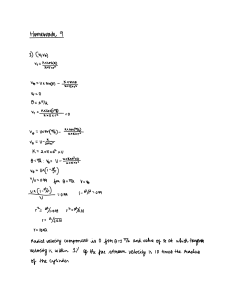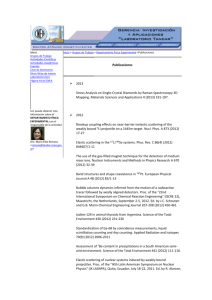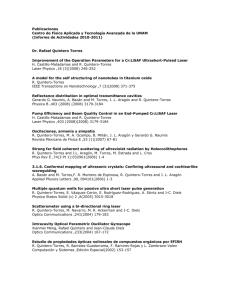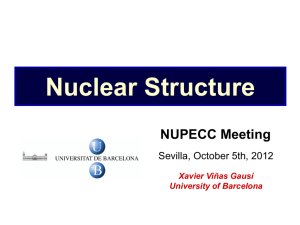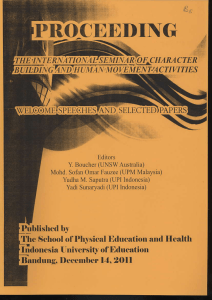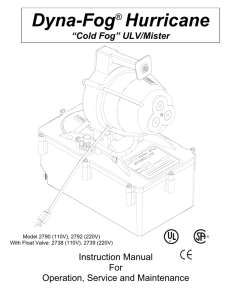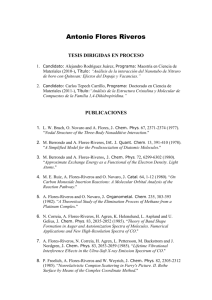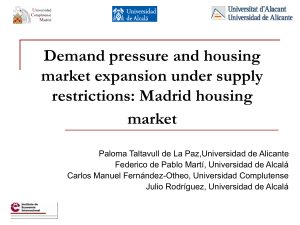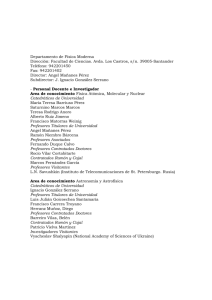References. - Pmmh
advertisement
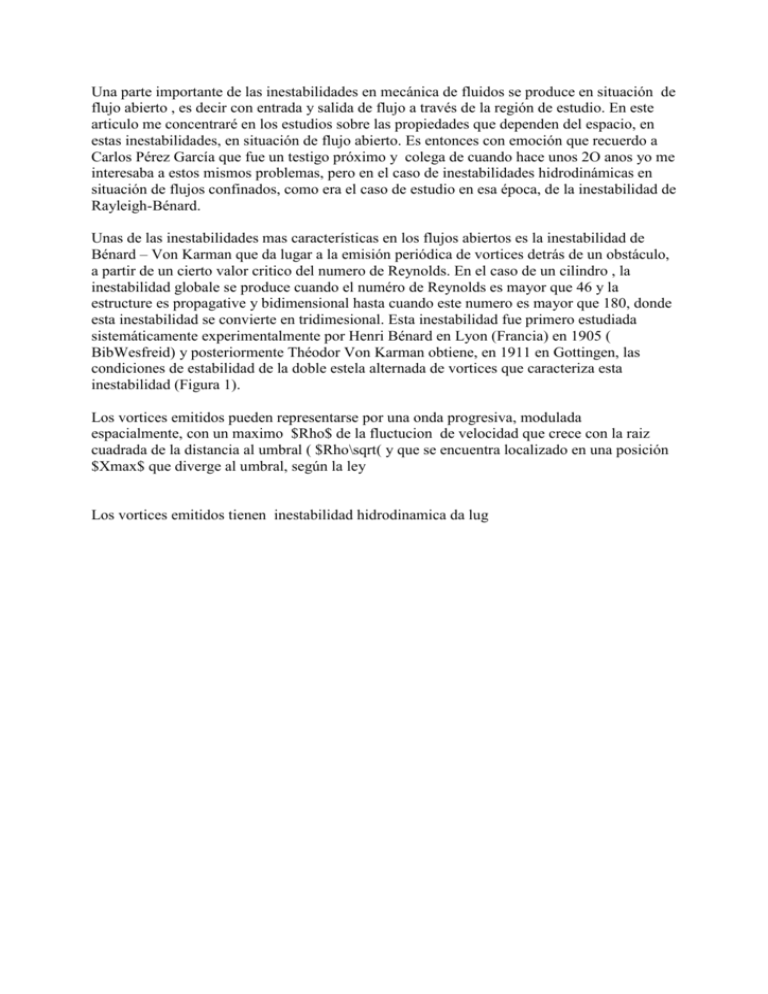
Una parte importante de las inestabilidades en mecánica de fluidos se produce en situación de flujo abierto , es decir con entrada y salida de flujo a través de la región de estudio. En este articulo me concentraré en los estudios sobre las propiedades que dependen del espacio, en estas inestabilidades, en situación de flujo abierto. Es entonces con emoción que recuerdo a Carlos Pérez García que fue un testigo próximo y colega de cuando hace unos 2O anos yo me interesaba a estos mismos problemas, pero en el caso de inestabilidades hidrodinámicas en situación de flujos confinados, como era el caso de estudio en esa época, de la inestabilidad de Rayleigh-Bénard. Unas de las inestabilidades mas características en los flujos abiertos es la inestabilidad de Bénard – Von Karman que da lugar a la emisión periódica de vortices detrás de un obstáculo, a partir de un cierto valor critico del numero de Reynolds. En el caso de un cilindro , la inestabilidad globale se produce cuando el numéro de Reynolds es mayor que 46 y la estructure es propagative y bidimensional hasta cuando este numero es mayor que 180, donde esta inestabilidad se convierte en tridimesional. Esta inestabilidad fue primero estudiada sistemáticamente experimentalmente por Henri Bénard en Lyon (Francia) en 1905 ( BibWesfreid) y posteriormente Théodor Von Karman obtiene, en 1911 en Gottingen, las condiciones de estabilidad de la doble estela alternada de vortices que caracteriza esta inestabilidad (Figura 1). Los vortices emitidos pueden representarse por una onda progresiva, modulada espacialmente, con un maximo $Rho$ de la fluctucion de velocidad que crece con la raiz cuadrada de la distancia al umbral ( $Rho\sqrt( y que se encuentra localizado en una posición $Xmax$ que diverge al umbral, según la ley Los vortices emitidos tienen inestabilidad hidrodinamica da lug Spatial inhomogeneities of hydrodynamic instabilities from Rayleigh-Bénard convection to Bénard-von Karman street Sophie GOUJON-DURAND1*, José Eduardo WESFREID2 Physique et Mécanique des Milieux Hétérogènes (PMMH –UMR 7636 CNRS) Ecole Supérieure de Physique et Chimie Industrielles de Paris (ESPCI) 10, rue Vauquelin, 75005 Paris, France *Université Paris 12, 61 Av. du Général de Gaulle, 94010 Créteil, France e-mail :1 sophie@pmmh.espci.fr, 2wesfreid@pmmh.espci.fr, Abstract We describe the spatial inhomogeneities in hydrodynamic patterns, in the cases of confined systems such as the Rayleigh-Bénard convection and open systems such as as the Bénardvon Karman instability of vortex shedding. From experimental results, we define the typical correlation lengths and their scaling law in each situation. 1. Study of envelope of Rayleigh-Bénard instability. In the study and modelization of the hydrodynamic instabilities, the experiments concerning the thermoconvective Rayleigh-Bénard instability were determinant. This instability, created by heating the bottom of a horizontal layer of fluid, presents a remarkable spatial organisation in the shape of convection rolls when the temperature gradient applied on the layer reaches a critical value. Modern studies of this instability have permitted the application of the universality concepts and scaling laws from Condensed Matter Physics, to other areas as Fluid Mechanics. Rayleigh-Bénard instability has been the subject of many studies, particularly in the non-linear dynamics, deterministic chaos [1] as well as spatiotemporal chaos [2] and developed turbulence [3]. The doctoral thesis of Henri Bénard defended at the Sorbonne in 1901, devoted to the thermal convection with the free surface, opened the field of systematically experimental study of instabilities for the physicists, using accurate methods of observation, particulary optical methods [4]. This field is known as “Bénard-Marangoni convection” One of the subjects that we would like to review briefly is the evolution of the spatial envelope, i.e. the maximum amplitude of one of the velocity components of the convective rolls in the Rayleigh-Bénard instability. One of the representative values of the state of the system, near onset of instability, is given by the amplitude A(x) which represents the spatial envelope of the rolls structure, of wavenumber q in the 2D convection . So, for the stationary case, one velocity component is characterised by V = A(x) cos (qx+), where x is the position variable in the direction perpendicular to the rolls and is the phase perturbation. In that situation the amplitude A is the order parameter of the transition. A real flow is characterized by spatial inhomogeneities : presence of walls structure defects, thickness variations and so on. The extension of macroscopic perturbations, i.e. the size of the boundaries layers in the “ rolls” domain, is estimated by equivalence with the correlation length of the system. The coherence length (or influence length), was determined using Laser Doppler Velocimetry, by measurement the influence on side boundaries of the cells away from L associated to the conditions A(0) = A(L) = 0, on the convective structure [5,6], (Fig .1) The coherence length is related to the relative distance at the onset of instability = R/Rc – 1, where R is the Rayleigh number (adimensional temperature difference) and Rc its critical value at the onset instability. This length shows critical behaviour in ~ -1/2-, whether beyond or below onset of instability. Other experiments allowed to determine the amplitude law A ~ 1/2 in the cells of the large lateral extension and showed the critical slowing down of the temporary perturbations with characteristic time varying as -1 This series of experiments [7] has permitted, for the first time, to verify the validity of the slightly non-linear Newell-Whitehead-Segel model which represents the particular case of the Ginzburg-Landau amplitude equation for Rayleigh-Bénard convection. These equations and their generalization have since been widely used as model equations of a whole instabilities problems in confined systems [8]. It is interesting today to recognize that Pierre Bergé and his Saclay group have played a prominent role in the production of these scientific results and in developing optical methods and physical concepts relevant for the Bénard work. The impact of their approach extended to the study of defects in convective structures which have been treated in general terms by considering the effect of compression and deformation of structures at the large scale of the amplitude equation [9,10,11]. 2. Study of the downstream evolution of the Bénard-von Karman instability. In the last years, theoretical and experimental studies have been focused on hydrodynamic instabilities in open systems. The most typical cases are due to shear forces as in mixing layers or behind a bluff body which induce vortex shedding, in turn provoking transverse vortices in the flow. Other instabilities produce stationary vortex in the flow direction, streamwise or longitudinal vortex as a result of centrifugal instabilities due to flow streamline curvature and the instabilities resulting from rotation or presence of stagnation points. These instabilities are largely represented in real flows either in natural conditions or in industry. In the first group we have Bénard-von Karman instability, characterized by vortex shedding in the flow behind an obstacle ( Fig. 2). In the case of a cylinder, of infinite lateral extent, the transition takes place when the Reynolds number (adimensional velocity) calculated on the diameter of the cylinder R = Vd / is Rc = 47 [12,13]. The base velocity profile U(x), where x is the distance in the stream direction, presents a strong shearing which is the source of instability. The strongest shearing occurs just behind a bluff body where two recirculation bubbles form. Downstream , the relaxation of the velocity profile, by viscous diffusion, reduces unstable features in the velocity profile. This spatial inhomogeneity of the base flow is characteristic of most of the instabilities in open systems, with, among other consequences, the presence of a normal component of the velocity, through flow conservation. The flow can in this way become non-parallel, if this inhomogeneity is strong enough. We are concerned ourselves with the spatial inhomogenities in the Bénard-vonKarman instabilities. The bluff body is of a trapezoidal or cylindrical form. We performed experiments in a low velocity water tunnel with a Laser Doppler Velocimeter ( LDV). The longitudinal (Vx) and transverse (Vy) velocity components of the instationary flow were measured along the central line of the flow behind the obstacle, for supercritical Reynolds numbers (R > Rc), when vortex shedding takes place. In this instability, the vortices behave like travelling waves with wavenumber q and constant frequency falong the flow. The amplitude or envelope A(x,y), defined in the previous section, accounts for the spatial modulation of intensity of shedding vorticies. Boundary conditions, on the bluff body and to infinity are A = 0. In Fig. 3 we are presenting the envelope A (x, ymax) of the longitudinal component of the perturbation of flow velocity vx = U – Vx. , where ymax is the transversal position of the maximum of the perturbation. This figure shows the typical shape of the envelope, increasing the value of maximum and bringing it closer to the bluff body, as the flow velocity or Reynolds numbers R increases [14]. Unlike what happens in confined instabilities, we observe here the deformation of the envelope with the Reynolds number. The value of the amplitude at the maximum of the envelope Amax follows a Landau law: Amax ~ 1/2 . The abscise Xmax of this envelope maximum measured from the extremity of the bluff body, follows the same law as the correlation length in the case of the Rayleigh-Benard instability, i.e. Xmax ~ -1/2 [15,16]. The existence of the two scaling laws allows us to renormalize the envelopes for each value of the Reynolds number, near the onset of instability, by scaling the velocity fluctuation of the velocity with Amax and the abscise with Xmax. This behaviour was also observed in 2D numerical simulations with spectral methods [17] (Fig. 4). These simulations have shown also that the envelope grows locally in the linear stage of perturbation growth and starts wrapping in the non linear stage. Spatial inhomogeneity of the vortex intensity is correlated with inhomogeneity of the base flow. Local study of the linear stability of the base flow in region of the near wake close to the recirculation rolls, shows the existence of the absolute instability (IA), i.e. a natural self-oscillation with narrow spectrum. Downstream the base flow presents a zone of convective instability (IC) with the large noise spectrum amplification. [18,19]. Although each local profile corresponds to instability onset and to different frequencies, the whole unstable system selects one unique frequency characterised by narrow spectrum (global frequency). The criteria to obtain this global frequency are still subject of theoretical investigation. The unstable flow thus presents a strong synchronisation of the oscillations of a global rather than local nature [20]. A retroaction mechanism, common to all flows where an absolute instability region is followed by a convective instability region downstream, results in the installation of the global mode, so the measured envelope is the amplitude of the global mode. The separation between IA and IC regions in XA can be assimilated to a virtual, permeable boundary of the system. Further downstream we have one point where base flow profile becomes linearly stable because of the relaxation of the shear profile. Increasing part of the envelope (between bluff body and Xmax ) defines a wave propagation front, with a thickness ~ -1/2 . If this length is smaller than the distance between the bluff body and the XA coordinate, it is to be expected that Xmax coincides with the thickness of the wave front [21]. On the other hand if XA is smaller than this, we observe a strong inhomogeneity situation ( “small box”) but without the same scaling laws. This is always the case for very small values of , as appears in confined system instabilities, where the correlation length is about the size of the box [7]. 3. Current developments. This short summary of results concerns the spatial inhomogeneities in the open systems instabilities as Bénard-von Karman instabilities. Other problems of interest are the spatial amplitude of the non-linear stationary mode or zero frequency mode, which is of major importance in unstable flows. Indeed, one of the most significant non-linearities is the quadratic one that generates a zero frequency mode (stationary) of order , describing the deformation of the base flow caused by instability [22,23,24]. In the case of wake (Bénard-von Karman instability), the spatial distribution or envelope of this zero mode is concentrated on the axis, in the recirculation region behind the bluff body [17]. This localisation has as effect to pump the fluid inside the region of the negative velocity to oppose recirculation. For stationary flow (without vortex emission), between the existence of recirculation loops ( R ~ 5) and until the appearance of vortex shedding ( R = Rc= 47), the recirculation length Lro increases with flow velocity Uo [25,26] according to Lro ~ Uo. The existence of the zero-frequency mode decreases locally the flow velocity in this region in a quantity proportional to , so that for Reynolds numbers R > Rc, the size of the recirculation area Lrv, in presence of the vortex emission should vary as Lrv ~ (Uo-Cte. ) a phenomenon that we have been able to put in evidence [27]. In addition this mode modify the mean drag [28,29]. Finally recent investigations on the wakes behind a bluff body have been concerned with developed turbulence situations. Their interest lays in the inhomogeneous character of the turbulence which involves the impact of coherent structures in their statistics. The latter are more significant in near wake than in far wake where turbulence is more homogenous. In this way intermittency exponents [30] measuring deviation from the predictions of Kolmogorov theories in 1941 exhibit a spatial variation with a stronger intermittency in the near wake tending towards values characteristic of homogenous turbulence in far wake. [31,32]. Acknowledgments. The first part of this work (Rayleigh-Bénard convection) was done by J. E. Wesfreid with Pierre Bergé, Monique Dubois, Christianne Normand, and Yves Pomeau in Saclay. Work on the wake was developed at the ESPCI, with Patrice Jenffer, Barbara Zielinska, Jan Ducek, Eric Gaudin, Bartosz Protas and Jan Wojciechowski. We thank them for this collaboration. References. [1] P. Bergé, Y. Pomeau, C. Vidal, Order within Chaos (Hermann, Paris, 1984) [2] P. Bergé, Y. Pomeau, C. Vidal, L’espace chaotique (Hermann, Paris, 1998). [3] B. Castaing, G. Gunaratne, F. Heslot, L. Kadanoff, A. Libchaber, S. Thomae, X. Wu, S. Zaleski, G. Zanetti, J. Fluid. Mech. 204, 1 (1989) [4] J. E. Wesfreid. Bull. S.F.P. suppl. 81, 39 (1991) and these proceedings. [5] J. E. Wesfreid, Y. Pomeau, M. Dubois, C. Normand and P. Bergé, J. Phys. (France) 39, 725 (1978). [6] J. E. Wesfreid, M. Dubois, P. Bergé, Phys. Rev A 19, 1231 (1979). [7] J. E. Wesfreid, Etude de la convection de Rayleigh-Bénard au voisinage du seuil de convection, Thèse de doctorat d’Etat, Université de Paris-Sud, 1981. [8] P. Manneville, Dissipative structures and weak turbulence (Academic Press. Boston, (1990). . [9] Y. Pomeau, P. Manneville, J. Phys. Lett. 40, 609 (1979) [10] J.E. Wesfreid, V. Croquette Phys. Rev. Lett. 45, 634 (1980). [11] J.E. Wesfreid, S. Zaleski, Cellular Structures in Instabilities, Lecture Notes in Physics n° 210, Ed., Springer, Berlin 1984. [12] C. Mathis, M. Provansal, L. Boyer, J. Phys. Lett. 45, 483 (1984). [13] M. M. Zdravkovich, Flow around circular cylinders, Oxford Science Publications(1997). [14] C. Mathis, Propriétés des composantes de vitesse transverses dans l’écoulement de Bénard-von Karman aux faibles nombres de Reynolds, Thèse Université d’Aix-enProvence, 1983. [15] S. Goujon-Durand, J. E. Wesfreid, P. Jenffer, Phys. Rev. E 50, 308 (1994). [16] J. E. Wesfreid, S. Goujon-Durand, B.J.A. Zielinska, J. Phys. II ( France) 6, 1343 (1996). [17] B. J. A. Zielinska, J. E. Wesfreid, Phys.Fluids 7, 344 (1995). [18] X. Yang, A. Zebib, Phys. Fluids A 1, 689 (1989). [19] K. Hanneman, H. Oertel Jr, J. Fluid Mech. 199, 55 (1989). [20] P. Huerre, P.A. Monkewitz, Annual Rev. Fluid Mech. 22, 473 (1990). [21] A. Couairon, J .M. Chomaz, Phys. Fluids. 11(12), 3369 (1999). [22] J. Dusek, P. le Gal, Ph. Fraunié, J. Fluid Mech. 264, 59 (1994). [23] V. Pagneux, A. Maurel, Comp. Rend. Acad. Sci. (Paris) 319, 27 (1994). [24] A. Maurel, V. Pagneux, J.E.Wesfreid, Europhys. Lett. 32, 217 (1995). [25] M. Nishioka, H. Sato, J. Fluid Mech. 89, 49 (1978). [26] M. Coutanceau, R. Bouard, J. Fluid Mech. 79, 231 (1977). [27] B. J .A. Zielinska, S. Goujon-Durand, J. Dusek, J. E. Wesfreid, Phys. Rev. Lett. 79, 3893 (1997). [28] B. Protas, J. E. Wesfreid, Phys. Fluids 14, 810 (2002). [29] B. Protas, J. E. Wesfreid, C.R. Mécanique 331, 49 (2003). [30] U. Frisch, Turbulence: The legacy of A.N. Kolmogorov, Cambridge University Press, (1995). [31] E. Gaudin, B. Protas, S. Goujon-Durand, J. Wojciechowski, J. E. Wesfreid, Phys.Rev. E 57, R9 (1998). [32] B. Protas, S. Goujon-Durand, J. E. Wesfreid, Phys. Rev. E 55, 4165 (1997). Figure 1. Amplitude modulation induced by wall effects in thermal convection [5]. Figure 2. Laser induced flurosceine view of vortex emission [13]. Figure 3. Spatial evolution of the amplitude A(x, ymax) of the longitudinal components of the velocity perturbation [14]. Figure 4. Renormalisation curve of the envelope for the Vx and Vy components [12]
